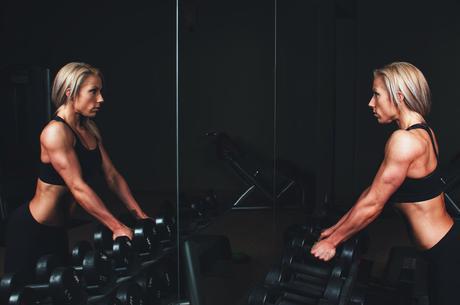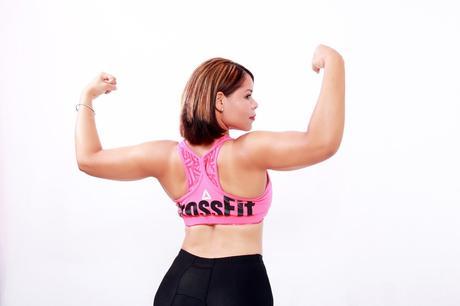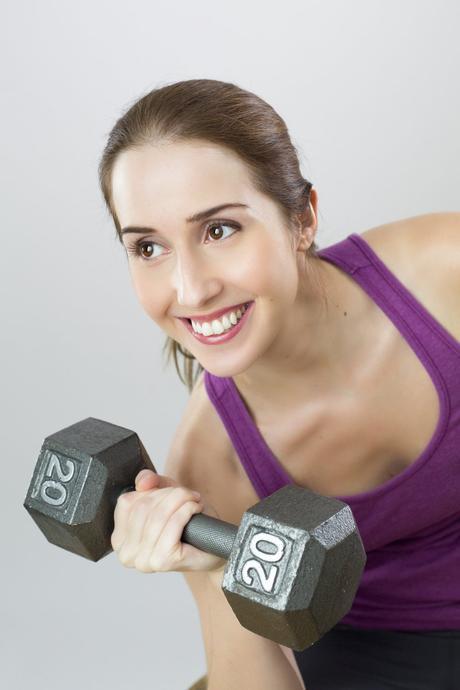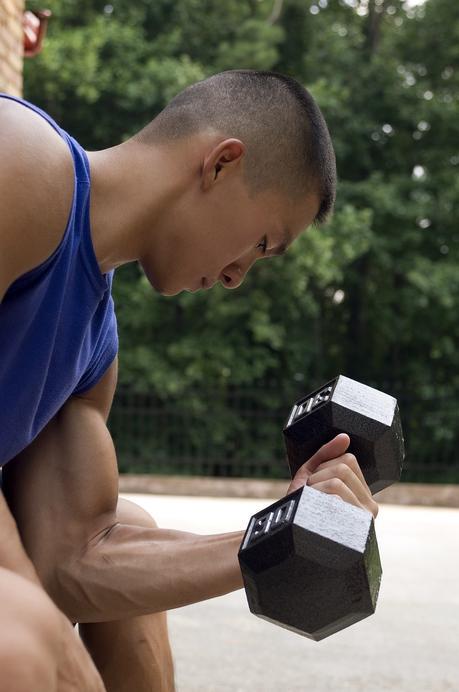
Arm Toning Exercises
It seems flabby arms or saggy skin where your triceps used to be is an inevitable sign of aging. No matter what arm toning exercises you employ it feels near impossible to maintain muscle definition.
The back of the arms are a common problem area when toning, particularly for women who tend to store a higher volume of fat in the upper arms. Many women become extremely self conscious, feeling the need to continually cover up. This fuels an additional burden at the height of summer when a singlet or tank top is most appealing.

Arm toning problems
How to fix flabby arms is a regular question directed at fitness trainers or by users scouring the internet for advice. The majority aren’t after a muscle bound physique, they simply wish to eliminate their ‘bat wings’ - a source of ongoing stress and embarrassment. Despite a concerted effort most people struggle, no matter how many toning exercises they endure.
Why are toning efforts failing to reduce the fat in your upper arms? Let’s look at 5 of the most common reasons below.
Your workout consists of biceps curls and triceps presses

How to fix flabby arms?
If you want sexy sculpted arms it makes sense to exercise those muscles directly right? It certainly sounds like a reasonable theory. In reality this is not always an effective approach.
The cause of flabby arms is excess fat. To tone them you need to reduce subcutaneous fat levels. And now for the bad news… no volume of arm toning exercises will do it for you.
While hundreds of biceps curls or triceps dips may strengthen or expand your arm muscles, they’re unlikely to elicit the significant fat burning response required to reduce excess fat.
Related: The 50 Best Exercises For Weight Loss You Should Consider Adding To Your Workout
Spot reduction refers to the theory fat can be targeted for reduction in a specific area of the body. For example, a common belief exists that exercising the abdominal region is an effective way to lose belly fat. It isn’t. It’s not possible to reduce fat in a certain area by exercising that body part alone. The same applies to losing unwanted fat in your arms.
How can I be sure? A 12 week study involving 104 participants was completed by the University of Connecticut in 2007. Participants completed supervised resistance training on their non-dominant arm only. Researchers observed subcutaneous fat loss tended to be generalised throughout the body, rather than occurring predominantly in the trained arm. A number of other studies have confirmed these findings.
You’re not pushing yourself hard enough

Biceps curl image - are you working out hard enough?
The second common reason individuals fail to reduce arm fat is they’re not working out hard enough, or perhaps often enough.
It may be your weights are too light to stimulate a significant training effect.
A study published in the Journal Medicine & Science in Sports & Exercise compared women who lifted higher weights for fewer reps (85% 1RM for 8 reps) against those lifting 15 reps at a lighter weight (45% 1RM). The result? Heavy lifters burned nearly twice as many calories in the 2 hours following their workout.
"Lifting weights can increase your lean body mass, which increases the number of overall calories you burn during the day,” according to spokesperson for the American Council on Exercise Jacque Crockford. Lifting heavier weights in the 8-12 rep range has been correlated with enhancing lean muscle development.
Perhaps you're relying on cardio exercise to burn calories and fix those flabby arms.
Related: Is Weight Training Or Cardio The Best Way To Burn Stomach Fat?
The intensity of your workout is integral to fat burning efforts. You might want to increase your effort with some HIIT training. HIIT, or high intensity interval training is an exercise approach where periods of almost maximal effort are interspersed with lower effort recovery.
A study by Tremblay et al exposed participants to a 15 week research trial comparing aerobic steady state exercise to HIIT training. Subjects completed either a 40 minute moderate intensity cycling effort or high intensity intermittent sprints. Participants completing higher intensity training lost significantly more body fat than their counterparts.
You aren't exercising your entire body
Biceps curls and triceps presses are examples of ‘isolation’ exercises. An isolation movement is one that involves a single joint and one major muscle group. For example: a curl engages the biceps muscle as the dominant muscle group, and is responsible for moving the elbow joint.
A more effective approach to reducing subcutaneous fat is incorporating multi joint or 'compound' exercises into your workout. You’ve probably already guessed, but for clarity - compound exercises activate multiple muscle groups at once.
Squats, chin ups and dead lifts are all examples of compound movements. A squat, for instance, engages the quadriceps, hamstrings and gluteal muscle groups to coordinate an efficient movement. The hip, ankle and knee joints are all involved in the motion.
Why are compound movements better to include in your workouts?
Shifting your focus from single joint isolation to compound exercises engages increased musculature. Working out a greater volume of muscle means an increase in calorie burning both during training and after a workout is complete. It also causes a positive hormonal response that stimulates lean muscle growth, such as increases in testosterone and growth hormone.
You're doing too many reps

Too many reps?
Are you still adhering to the ‘higher reps are better for toning’ school of thought?
This myth was busted a long time ago. However, it's alarming the number of individuals who remained convinced 15-25 reps with a low weight is optimal for toning their body.
I mentioned earlier the way to tone your flabby arms is actually by reducing your body fat percentage enough to get rid of the jiggle in your arms, and (eventually) to expose the definition and shape of your muscles again.
Related: Avoid These 4 Totally Overrated Weight Loss Exercises
High reps won’t do this for you. Your muscles need to be stressed to adapt and grow. If you are not progressively overloading your muscles you won't build lean muscle and you will not induce a significant fat burning response. Some studies have shown that strength training can actually elevate your metabolism for up to 38 hours after your workout.
For the best fat loss results stick to weights that produce fatigue in the 8-12 rep range. What does that mean? It means if you can do more than 12 reps… the weight is too light. If you can't get to 8 before faltering… the weights are too heavy. Modify the resistance as you experience strength improvements.
Don’t worry. Heavy weights with lower reps won't leave you big and bulky. Building muscle is not easy. The muscle bound crew you see in the gym have trained extremely hard over a long period to achieve their physique. Most of us don’t possess the genetic support to build large muscles.
We do however have the ability to add attractive lean muscle to our frame that not only makes you look slimmer and more attractive, but also helps boost your fat burning metabolism.
A poor diet means you'll never get rid of flabby arms

Diet impact of flabby arms
To achieve definition in your arms, you need to alter your body fat composition. We've established that already. While exercise is important, if you want to reduce your body fat to a level where the muscles in your arms are visible again then exercise alone is not enough.
If your diet is poor, you simply won't achieve the required level of fat loss.
To lose one pound of fat per week you need to create a 3500 calorie deficit. Two pounds and you are looking to burn 7000 calories more than you ingest through food. It's far easier to achieve this sort of deficit through dietary modifications than exercise.
Related article: The Exercise Myth: Science Says Exercise Not The Best Way To Burn Stomach Fat
A 12 month study involving 439 obese sedentary women investigated the effects of diet vs exercise on weight loss. Researchers compared the impact of a calorie reduced low fat diet on weight loss both independently and when combined with moderate intensity aerobic exercise. Subjects in the exercise treatment groups completed five sessions per week of 45 minutes duration.
Related: 7 Surprising Foods That Burn Fat Like Crazy
Confirming the suspicions dietary modification is more impactful, the diet only group demonstrated the highest average weight loss, an 8.5% reduction. The exercise only group recorded a significantly lower 2.4% loss.
A combined exercise and diet group observed a 10.8% fat loss, suggesting an intervention of diet and exercise is best for reducing adiposity... and in this case repairing the flabby arms you have been struggling with.
Related: Research Says: Diets Don't Work And Won't Reduce Fat From Belly

